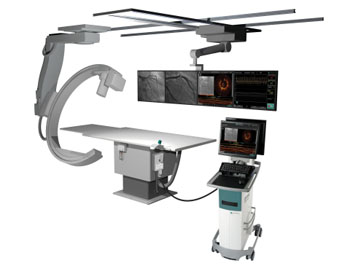Mobile System Combines OCT Imaging with Angiography
By MedImaging International staff writers
Posted on 15 Feb 2016
A new diagnostic system couples state-of-the-art optical coherence tomography (OCT) and angiography co-registration into one portable system for hospitals with multiple catheterization labs. Posted on 15 Feb 2016
The OPTIS Mobile System uses the combination technology to help physicians make improved stenting decisions based on high-resolution and three dimensional (3D) OCT views of coronary anatomy, while simultaneously mapping their exact location via an angiogram. By using OCT technology, the system provides anatomical images of disease morphology and automated measurements that help physicians to visualize and measure important vessel characteristics that are otherwise not visible or difficult to assess with older imaging technology.

Image: The OPTIS mobile imaging system (Photo courtesy of St. Jude Medical).st jude
As a result, the automated, highly accurate measurements can guide stent selection, deployment, and placement ensuring successful procedures, and helping to minimize repeat revascularizations. The system also integrates proprietary fractional flow reserve (FFR) technology to offer detailed coronary hemodynamic circulatory information during percutaneous coronary intervention (PCI). The OPTIS Mobile System is a product of St. Jude Medical (SJM; St. Paul, MN, USA), and has been approved for sale in Europe and Japan.
“The OPTIS Mobile System represents the ongoing commitment of St. Jude Medical to develop products that provide physicians with more options for improved OCT and angiography co-registration guidance in their daily practice,” said Eric Fain, MD, Group President of St. Jude Medical. “In contrast with intravascular ultrasound, OCT offers increased resolution and highly-detailed intracoronary arterial views, which can improve PCI procedures, especially in complex cases.”
“As the interventional cardiology landscape continues to expand, there is a real need for more portable intravascular imaging systems to ensure hospitals with multiple catheterization labs have the right technology available for physicians to make more informed treatment decisions during PCI,” said Nick West, MD, of Papworth Hospital (Cambridge, United Kingdom). “The imaging advancements offered with the OPTIS Mobile System provide the same benefits of the OPTIS Integrated System, and allow physicians to clearly visualize complex cardiac anatomy and evaluate how to best proceed during PCI.”
FFR is a physiological index used to determine the hemodynamic severity of atherosclerotic narrowing of the coronary arteries, and is measured using proprietary SJM PressureWire Aeris and Certus systems. FFR specifically identifies which coronary narrowing is responsible for the ischemic obstruction of the flow of blood to a patient’s heart muscle and helps guide the interventional cardiologist in determining which lesions warrant stenting, resulting in improved patient outcomes and reduced health care costs.
Related Links:
St. Jude Medical














